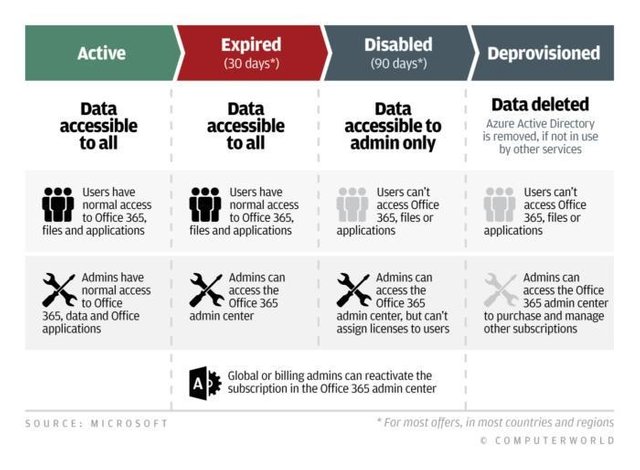What happens when an Office 365 subscription expires?
Three-stage process eventually ends up with all cloud data deleted

Microsoft's pay-as-you-go Office 365 is, first and foremost, a subscription. And like other subscriptions -- think newspapers (remember them?) or an online storage service -- missing a payment doesn't immediately mean you're cut off.
Because it's less expensive to retain a current subscriber than find a new subscriber as a replacement, providers sometimes go to great lengths to keep customers on the rolls.

When a business misses an Office 365 payment, or cancels the service, the applications and data don't immediately disappear. Instead, Microsoft steps a customer through a three-stage process that gradually decreases both employee and administrator access, but for months leaves the door open to a renewal.
Here are the stages of an Office 365 breakup.
1-30 days after subscription ends: Expired
Microsoft dubs the first stage "expired," but it could just as well be called "grace period," since everything works as if the customer's payments remain up to date.
Users have normal access to all Office 365 applications and services under the company's plan. Already-installed applications can be launched, no data will be scrubbed from Microsoft's servers -- such as email messages or files stored on OneDrive for Business -- and additional applications can be added to a user's devices.
Note: macOS versions of Office provided via an Office 365 subscription do not include the 30-day grace period; they immediately enter the "Disabled" state. See below for details.
Administrators can access all functions from the Office 365 admin center portal, including assigning licenses to new or existing employees. If the firm plans to depart Office 365, data may be backed up.
MORE LIKE THIS
Microsoft to slash cloud-connection rights for stand-alone Office
Office 365: A guide to the updates
Review: Microsoft Office 365 vs. Google Apps
VIDEO
Mingis on Tech: Google rolls out the hardware
The subscription can be renewed by the global or billing administrator during this 30-day span.
31-120 days after subscription ends: Disabled
During months two through four, the subscription sits in the "disabled" state. Another label could be "admin only," as administrators can continue to access the admin portal. The IT staff can most effectively use this period to back up employee data stored on Microsoft's servers. Admins cannot assign licenses to workers during the 90 days.
Users are unable to log into their Office 365 accounts and so are blocked from Office 365 services included in the plan, ranging from hosted email to OneDrive for Business. The locally-installed applications will drop into what Microsoft's calls "reduced functionality," meaning that most features and tools are unavailable. Files may be opened, viewed and printed, but not edited or saved. The applications may not launch from the desktop, but they will open after clicking on an appropriate document.

computerworld
Search for
Go
Browsers
Cloud Computing
Computer Hardware
Consumerization of IT
Data Centers
Emerging Technology
IT Leadership
Internet
Mobile
Networking
Operating Systems
Security
Software
Vertical Industries
All Topics
News
Features
Reviews
Blogs
Opinions
Insider
Shark Tank
Slideshows
Video
Digital Magazine
Digital Downloads
Newsletters
Computerworld Events
Resources/White Papers
NEWS ANALYSIS
What happens when an Office 365 subscription expires?
Three-stage process eventually ends up with all cloud data deleted
By Gregg Keizer
Senior Reporter, Computerworld
JUL 11, 2017 9:35 AM PT
cw office data accessibility
Credit: April Montgomery / IDG
Microsoft's pay-as-you-go Office 365 is, first and foremost, a subscription. And like other subscriptions -- think newspapers (remember them?) or an online storage service -- missing a payment doesn't immediately mean you're cut off.
Because it's less expensive to retain a current subscriber than find a new subscriber as a replacement, providers sometimes go to great lengths to keep customers on the rolls.
When a business misses an Office 365 payment, or cancels the service, the applications and data don't immediately disappear. Instead, Microsoft steps a customer through a three-stage process that gradually decreases both employee and administrator access, but for months leaves the door open to a renewal.
Here are the stages of an Office 365 breakup.
1-30 days after subscription ends: Expired
Microsoft dubs the first stage "expired," but it could just as well be called "grace period," since everything works as if the customer's payments remain up to date.
Users have normal access to all Office 365 applications and services under the company's plan. Already-installed applications can be launched, no data will be scrubbed from Microsoft's servers -- such as email messages or files stored on OneDrive for Business -- and additional applications can be added to a user's devices.
Note: macOS versions of Office provided via an Office 365 subscription do not include the 30-day grace period; they immediately enter the "Disabled" state. See below for details.
Administrators can access all functions from the Office 365 admin center portal, including assigning licenses to new or existing employees. If the firm plans to depart Office 365, data may be backed up.
MORE LIKE THIS
Microsoft to slash cloud-connection rights for stand-alone Office
Office 365: A guide to the updates
Review: Microsoft Office 365 vs. Google Apps
VIDEO
Mingis on Tech: Google rolls out the hardware
The subscription can be renewed by the global or billing administrator during this 30-day span.
31-120 days after subscription ends: Disabled
During months two through four, the subscription sits in the "disabled" state. Another label could be "admin only," as administrators can continue to access the admin portal. The IT staff can most effectively use this period to back up employee data stored on Microsoft's servers. Admins cannot assign licenses to workers during the 90 days.
Users are unable to log into their Office 365 accounts and so are blocked from Office 365 services included in the plan, ranging from hosted email to OneDrive for Business. The locally-installed applications will drop into what Microsoft's calls "reduced functionality," meaning that most features and tools are unavailable. Files may be opened, viewed and printed, but not edited or saved. The applications may not launch from the desktop, but they will open after clicking on an appropriate document.
A subscription can still be renewed by the global or billing administrator during this stretch.
121 days and up: Deprovisioned
At the Day 121 mark, the Office 365 subscription is not only dead, it's really, really dead.
No one, administrators included, can access service or applications, so backing up employee data is impossible.
In fact, Microsoft will begin to delete the subscription's data from its servers starting on this date. The company does not provide a done-by deadline, saying, "You can expect data to be permanently deleted in a reasonable timeframe after the 120 days have elapsed." Enterprises that want data erased as soon as possible may request "expedited deprovisioning" by calling support. Microsoft will then delete the pertinent data within three days.
Global or billing admins may not restore a subscription -- and thus access to the cloud-based data and the Office applications -- during this period. Assuming the firm wants to continue using Office, it must purchase new Office 365 subscriptions or standalone, perpetual licenses.
That's used simple and crack one :)
Thank You talk like this